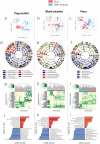Fish Skin and Gut Microbiomes Show Contrasting Signatures of Host Species and Habitat
- PMID: 32503908
- PMCID: PMC7414953
- DOI: 10.1128/AEM.00789-20
Fish Skin and Gut Microbiomes Show Contrasting Signatures of Host Species and Habitat
Abstract
Teleost fish represent an invaluable repertoire of host species to study the factors shaping animal-associated microbiomes. Several studies have shown that the phylogenetic structure of the fish gut microbiome is driven by species-specific (e.g., host ancestry, genotype, or diet) and habitat-specific (e.g., hydrochemical parameters and bacterioplankton composition) factors. However, our understanding of other host-associated microbial niches, such as the skin mucus microbiome, remains limited. The goal of our study was to explore simultaneously the phylogenetic structure of the fish skin mucus and gut microbiome and compare the effect of species- and habitat-specific drivers on the structure of microbial communities in both tissues. We sampled 114 wild fish from 6 populations of 3 ecologically and phylogenetically contrasting Amazonian teleost species. Water samples were collected at each site, and 10 physicochemical parameters were characterized. The skin mucus, gut, and water microbial communities were characterized using a metabarcoding approach targeting the V3-V4 regions of the 16S rRNA. Our results showed a significant distinction between the phylogenetic profile and diversity of the microbiome from each microbial niche. Skin mucus and bacterioplankton communities were significantly closer in composition than gut and free-living communities. Species-specific factors mostly modulated gut bacterial communities, while the skin mucus microbiome was predominantly associated with environmental physicochemistry and bacterioplankton community structure. These results suggest that the variable skin mucus community is a relevant target for the development of microbial biomarkers of environmental status, while the more conserved gut microbiome is better suited to study long-term host-microbe interactions over evolutionary time scales.IMPORTANCE Whether host-associated microbiomes are mostly shaped by species-specific or environmental factors is still unresolved. In particular, it is unknown to what extent microbial communities from two different host tissues from the same host respond to these factors. Our study is one of the first to focus on the microbiome of teleost fish to shed a light on this topic as we investigate how the phylogenetic structure of microbial communities from two distinct fish tissues are shaped by species- and habitat-specific factors. Our study showed that in contrast to the teleost gut microbiome, skin mucus communities are highly environment dependent. This result has various implications: (i) the skin mucus microbiome should be used, rather than the gut, to investigate bacterial biomarkers of ecosystem perturbance in the wild, and (ii) the gut microbiome is better suited for studies of the drivers of phylosymbiosis, or the coevolution of fish and their symbionts.
Keywords: Amazon; fish; gut; habitat; host; microbiome; phylosymbiosis; skin; species; teleost.
Copyright © 2020 American Society for Microbiology.
Figures





Similar articles
-
Host species and habitat shape fish-associated bacterial communities: phylosymbiosis between fish and their microbiome.Microbiome. 2023 Nov 20;11(1):258. doi: 10.1186/s40168-023-01697-6. Microbiome. 2023. PMID: 37981701 Free PMC article.
-
Genomic and Environmental Factors Shape the Active Gill Bacterial Community of an Amazonian Teleost Holobiont.Microbiol Spectr. 2022 Dec 21;10(6):e0206422. doi: 10.1128/spectrum.02064-22. Epub 2022 Nov 29. Microbiol Spectr. 2022. PMID: 36445161 Free PMC article.
-
Interpopulation Variation in the Atlantic Salmon Microbiome Reflects Environmental and Genetic Diversity.Appl Environ Microbiol. 2018 Aug 1;84(16):e00691-18. doi: 10.1128/AEM.00691-18. Print 2018 Aug 15. Appl Environ Microbiol. 2018. PMID: 29915104 Free PMC article.
-
Global landscape of gut microbiome diversity and antibiotic resistomes across vertebrates.Sci Total Environ. 2022 Sep 10;838(Pt 2):156178. doi: 10.1016/j.scitotenv.2022.156178. Epub 2022 May 23. Sci Total Environ. 2022. PMID: 35618126 Review.
-
Host specificity of the gut microbiome.Nat Rev Microbiol. 2021 Oct;19(10):639-653. doi: 10.1038/s41579-021-00562-3. Epub 2021 May 27. Nat Rev Microbiol. 2021. PMID: 34045709 Review.
Cited by
-
Host biology, ecology and the environment influence microbial biomass and diversity in 101 marine fish species.Nat Commun. 2022 Nov 17;13(1):6978. doi: 10.1038/s41467-022-34557-2. Nat Commun. 2022. PMID: 36396943 Free PMC article.
-
Host-associated and Environmental Microbiomes in an Open-Sea Mediterranean Gilthead Sea Bream Fish Farm.Microb Ecol. 2023 Aug;86(2):1319-1330. doi: 10.1007/s00248-022-02120-7. Epub 2022 Oct 7. Microb Ecol. 2023. PMID: 36205738 Free PMC article.
-
Host species and habitat shape fish-associated bacterial communities: phylosymbiosis between fish and their microbiome.Microbiome. 2023 Nov 20;11(1):258. doi: 10.1186/s40168-023-01697-6. Microbiome. 2023. PMID: 37981701 Free PMC article.
-
Is the Intestinal Bacterial Community in the Australian Rabbitfish Siganus fuscescens Influenced by Seaweed Supplementation or Geography?Microorganisms. 2022 Feb 23;10(3):497. doi: 10.3390/microorganisms10030497. Microorganisms. 2022. PMID: 35336073 Free PMC article.
-
Microbiome differences between wild and aquarium whitespotted eagle rays (Aetobatus narinari).Anim Microbiome. 2022 May 23;4(1):34. doi: 10.1186/s42523-022-00187-8. Anim Microbiome. 2022. PMID: 35606841 Free PMC article.
References
-
- Nayak SK. 2010. Role of gastrointestinal microbiota in fish. Aquaculture Res 41:1553–1573. doi:10.1111/j.1365-2109.2010.02546.x. - DOI
Publication types
MeSH terms
Substances
LinkOut - more resources
Full Text Sources

